Water Quality Testing After Power Outages
During power outages - especially long outages - private water supplies will likely lose water pressure. When your water system loses pressure, there is an increase in risk of bacterial contamination because of potential system leaks or frost pit well locations.
A faulty pipe, pipe connection or water access point may allow contaminated water to be seep in to or be drawn in to system piping when there is no water pressure.
The Iowa Department of Natural Resources, Iowa Department of Public Health, and the State Hygienic Laboratory, recommend that you have your private water supply tested for drinking water safety after power outages where your water supply loses pressure.
No-cost private well water testing is available under the Grants to Counties Program through your local county environmental health office. You can find your local county contact at the following web link.
Contact information for your local County Sanitarian
If your water system has lost all pressure during a power outage, please consider using an alternative water source known to be safe - like bottled water - until your water testing indicates the well water is safe to consume.
Private Well Testing Information
Iowa's Private Well Grants Program (PWG) provides free water testing to all private well owners and users for the analytes listed below. The Iowa DNR recommends that all private well owners have their water tested at least annually. To get your private well tested, please contact your local county health department.
County Health Department - contact list (click here)
Private Well Services - Grant money available
In addition to private well testing, the PWG program offers funding for the private well related services listed below.
Please follow these steps:
- Contact your county health department (click here) and notify them that you are wanting one of the above services.
- Contact a DNR certified well contractor to perform the work. The bullets below tell what type of work each type of contractor can perform, and links to a list of those contractors sorted by their city of residence.
- Well Drillers (click here) - (Shock chlorination, well assessments, reconstruction, well plugging (except pump and plumbing work))
- Pump Installers (click here) - (shock chlorination, well assessments, reconstruction (upper 10 feet only), well plugging)
- Well Pluggers (click here) - (can only plug Class 1 and Class 3 wells - all other well plugging must be performed by a well driller or pump installer)
- Non-certified contractors or non-certified people are not legally allowed to perform well services in Iowa, so always double check with the person you hire to ensure they are certified by and on the lists linked above.
- Tell the contractor you are seeking Private Well Grants funds and will require the following documents following completion of work:
- Fully completed DNR form based on the type of work
- Itemized "paid" invoice
- Submit these items to the county health department (click here)
- The county will reimburse you directly once your required forms and invoice have been reviewed and approved.
More Information
If you are seeking testing for analytes that are not listed above, please contact your county health department to discuss your situation. If the county thinks additional testing is needed, the county may be able to contact the State Hygienic Laboratory to seek approval for further testing of more complex contaminants, or provide additional guidance to improve your water quality. Please see the State Hygienic Laboratory GTC website to learn more.
Private Well Grants - Guidance Document for Qualifying Services - this document provides detailed information regarding what types of wells and specific services qualify for PWG funding.
The PWG program is a collaborative program with administration through the Iowa Department of Health and Human Services (HHS), and technical assistance provided by the Iowa DNR's Private Well Program. To learn more about the PWG Program, please visit this HHS web page: Private Well Grants (PWG).
A summary of the private well testing process for private well owners is shown in the diagram below.
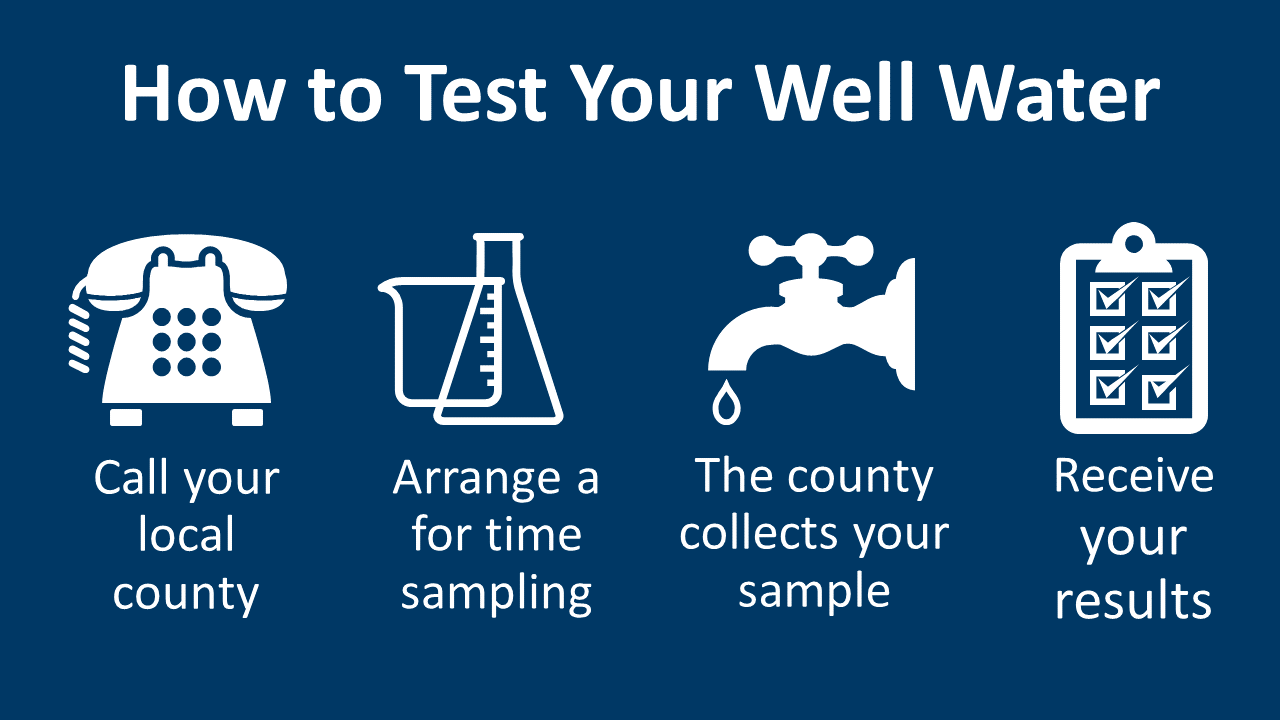

Important information for well owners whose wells are in or near flood areas
Contaminated well water can make you sick. Never consume water from a well if there is any chance the well has been impacted by flood waters. You need to test your well water to determine if it is safe.
Free Water Testing following flooding
Find out more by contacting your local county environmental health sanitarian. Ask to participate in the Private Well Grants Program for water testing administered by Iowa Health and Human Services (HHS).
sp;
- Test for coliform (bacteria) and fecal coliform (e.coli) to determine if additional well services like shock chlorination or well clean-out are needed to assist making the water coliform free.
- Note: Giardia, cryptosporidium, and other parasites from sewage and feces are not detectable with bacteria and e.coli tests, but can cause severe illness. Please see this CDC germs webpage to learn more. If you suspect that your well has been contaminated with flood water, then ask your local county health department to contact the State Hygienic Laboratory to test for those specific parasites.
- Test for nitrate as N. Then once each year unless near or above 10 mg/L as N, then twice each year is recommended.
If your well is positive for coliform (bacteria) and/or fecal coliform (e.coli), then you should take the following steps:
- Purge and shock chlorinate your well and water system
- Retest your well for bacteria, fecal coliform, and nitrate 7-10 days following shock chlorination (per Center for Disease Control guidelines).
- Repeat 1-2 until your well has zero coliform and fecal coliform.
- When nitrates near or above 10 mg/L as N, you should treat the consumable water used in the home. Information about treatment for private wells can be found here: https://www.iowadnr.gov/Environmental-Protection/Water-Quality/Private-Well-Program#13901282-water-treatment-information
Why you should take these steps
Floods can cause water quality problems with water supply wells - even if your well isn't directly in the flooded area. During a flood, the increased groundwater loading nearby a well can cause well contamination. Contaminated surface water can also leak into a well through defects in the well's casing or physically run over the top of the well and cause direct contamination of the aquifer.
Contaminants often found in flood water
Flood water often contains infectious bacteria, viruses, agricultural or industrial chemicals, and other hazardous agents. Keep in mind that anything that is being stored in flooded areas has the potential to be part of the flood water. Because of this, consuming contaminated water can cause serious illness - especially in infants, individuals with compromised immune systems, and our elderly population. Water testing is the only way to know if your well is affected. Note that parasites which are often found in flood water are not detectable with standard bacteria and e.coli tests. If you suspect that your well has been contaminated with flood water, then ask your local county health department to contact the State Hygienic Laboratory to test for those specific parasites.
Iowa DNR Well Flooding Guidance Documents
Additional Websites with Flooding and Flooded Well Information
Fact Sheets
Videos
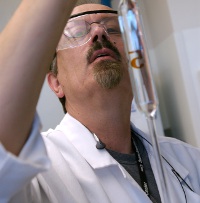
Is your well water safe to drink?
Here are some questions for you. Do you test your private well water? If so, do you test it at least once each year? If not, how long has it been since you last tested your private water supply? When your water experiences changes in the way it looks, smells or tastes, do you have a water test performed?
In general, many of Iowa's aquifers will provide safe and plentiful drinking water for your rural home or farm. Keeping that in mind, did you know that not every aquifer provides safe drinking water, or that well construction varies with the age of well and the well contractor used?
Safe drinking water is a complicated equation that includes the following variables:
- The well location and land use nearby the well site,
- the local geologic setting and aquifer used to obtain the water,
- the protective features/design of the well itself applied during well construction,
- the experience of the well contractor to recognize and overcome the potential local water quality issues, and
- the level of routine maintenance and water testing performed on the well by the well owner or well contractor.
This means that not all wells are constructed equally or access the same quality of water as other nearby wells. Changes in land use, well design, construction, and depth, can make a difference in well water quality.
The only way to know if your water supply is safe is to have the water tested. Any given year, less than 7 percent of Iowa's private well owners test their water supply. Within this group, many don't test their wells regularly.
The Iowa DNR and many public health agencies recommend that you test your private water supply at least once each year, and anytime you notice water quality changes - things like water color, clarity, taste, smell, or sediment.
When you test your well water, keep in mind that the contaminants you should test for can vary depending on the well depth, the type of construction and age of the well, and the well's location. Sometimes testing for the basics - bacteria, nitrate, arsenic, and manganese - may not be enough.
You can contact your local county environmental health department or a drinking water testing laboratory to inquire about well water testing that may be needed based on your location and concerns.
The DNR has guidance available to help you understand the importance of sampling and testing your private water system. Check out our Frequently Asked Questions About Private Drinking Water web page. To learn how you can qualify for free basic water testing, please contact your local county environmental health office and ask to participate in the Grants to Counties Well Testing Program.
Well Water Quality Information
Iowa Department of Public Health has a private water supply water quality data tracking portal. You can use the tool to review private well water quality around the state based on sample laboratory analysis.
You can view the data at the following link: IDPH Private Well Water Data Tracking Portal.
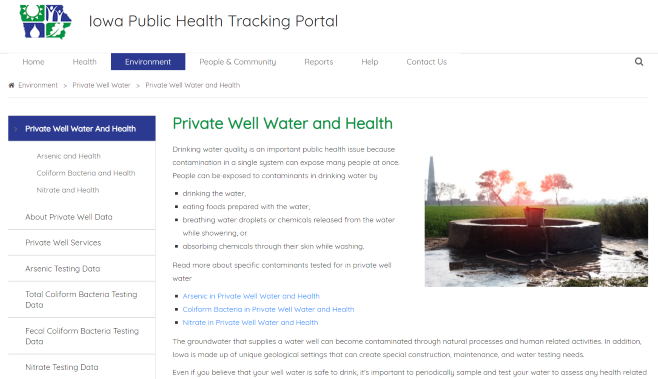
The Center for Health Effects of Environmental Contamination - also known as CHEEC - has a well forecaster webpage available that helps you understand the basic water quality in your region. Find out more by looking at the Iowa Well Forecasting System webpage.
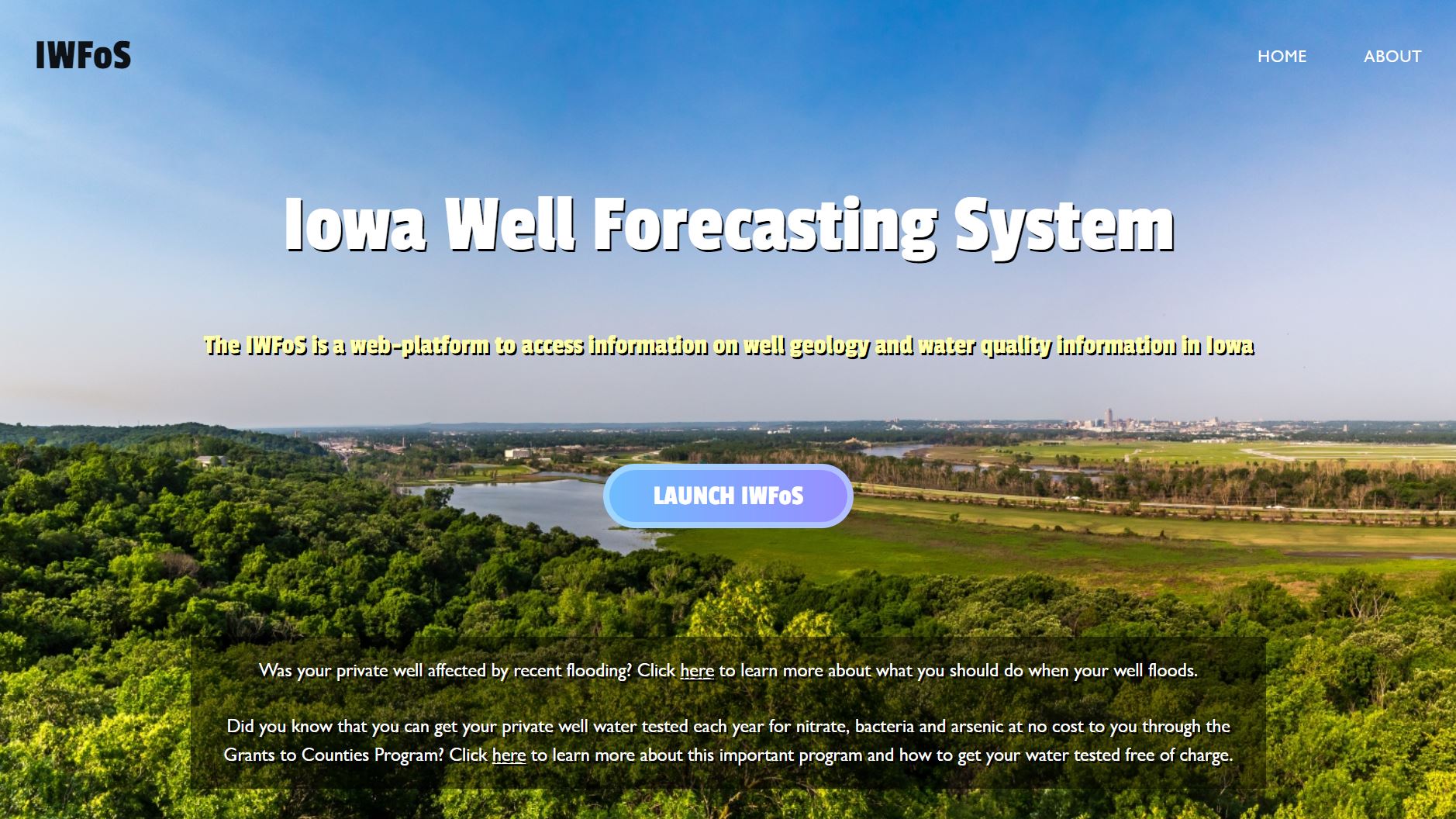

Water Quality should be on the minds of all private well users. Local water quality is a product of the geological setting your well is located in, the well's construction, and land use activities in your region and water shed.
The information below will provide a basic understanding on the topic of well water quality for the contaminants commonly tested for in private water supplies.
Nitrate
Nitrate in well water can be an issue with shallow water supply wells no matter where you live in Iowa. But did you know that there are places where deeper wells can also have high levels of nitrate?.
If you live in one of the red or green shaded area of map included with this topic, you are located in a Karst area. Constructing, maintaining, and using a well in Karst areas may be complicated by water quality issues. Wells finished in the shallow aquifers may contain high levels of nitrate and other chemicals that may cause health concerns. The only way to determine the quality of your well water is to have the water supply sampled and the water tested at a certified drinking water laboratory.
The Iowa DNR has basic information that can help you understand how your well may interact with shallow groundwater in these areas. Please see our Shallow Wells in Karst web page and our Private Wells in Karst Areas fact sheet for additional information.
Bacteria
Each day, we come into contact with millions of bacteria. Nearly all of them are harmless. But, some of these organisms are responsible for waterborne illnesses.
Total coliforms are a group of bacteria that are mostly harmless and found in soil and water, as well as the intestines of warm blooded animals. The presence of total coliforms in drinking water that comes from a water supply well can indicate that more dangerous bacteria - particularly fecal coliforms - have a pathway into the well and may also contaminated the water system..
Disease-causing bacteria, such as E. coli, can cause gastrointestinal illnesses, vomiting, diarrhea, and severe dehydration. It can also be life-threatening for infants, children, the elderly, and anyone who has a compromised immune system. Water that contains E. coli should never be used for any purpose where human contact or ingestion is a possibility.
Arsenic
Arsenic is an element that occurs naturally in rocks and soil. Recent concerns about arsenic in drinking water have left many private well users wondering if they should test their water for the presence of arsenic. This article provides you with information about areas where arsenic testing has been completed on private wells, how you can obtain testing of your water, and what to do if you find your water is high in arsenic.
The Iowa DNR's Arsenic testing recommendation. We recommend that all private well users have their well water tested for arsenic at least one time. If your arsenic level is elevated or high, you may need to perform arsenic testing more frequently. This allows you to monitor the level of arsenic and make informed decisions, like when to install a water treatment system to remove the contaminant, or when to stop drinking the water.
Where is Arsenic found in Iowa's groundwater? Prior studies indicate that arsenic is present in the groundwater at some level in many areas of our state. Voluntary statewide testing of private wells looking for arsenic began in 2015. This information has provided us with a better understanding on where arsenic may be a problem, but many areas of the state have not been tested. Further testing will help inform more well users of potential risk, increase our knowledge regarding which aquifers are affected, help well owners and well contractors predict where arsenic may be a problem, and potentially develop strategies on how to construct wells so they have lower levels of arsenic.
The map below indicates where arsenic testing has been done through March 20, 2017 and the approximate level of arsenic found in the water.

How to use the map. Look for your area and then look for a colored dot nearest to your location.
- A green dot indicates a well was tested near this location and no arsenic was detected the well water - this means there is no arsenic risk at this time. When your well doesn't have any arsenic present, we recommend that you retest for arsenic every 6 - 10 years to monitor for any change.
- A yellow dot indicates arsenic was detected in well water near this location, but less than 5 micrograms per liter (or µg/l) in concentration - a fairly low risk. We recommend you retest your well every 5 years to monitor for any change in the arsenic level.
- An orange dot indicates arsenic was detected in well water near this location and it's in the range of 5 - 8.9 µg/l - this is a mid to high arsenic concentration - but not above the recommended Maximum Contaminant Level (also known as MCL). We recommend that you retest your well every 2 - 4 years to monitor for any change in the arsenic level.
- A red dot indicates arsenic was detected in well water near this location with a concentration of 9 - 10 µg/l - this level is near or at the recommended MCL - we recommend that you retest your well for arsenic every 1 - 2 years to monitor for any change in the level.
- A black dot indicates that arsenic was detected in well water near this location and its level is above the MCL of 10 µg/l. This is above the recommended maximum level for drinking water. Water with 10 µg/l or higher of arsenic should not be consumed unless it's properly treated using a water treatment system specifically designed to remove arsenic. When using a water treatment system, it's important to test the treated water periodically and maintain the treatment system to ensure the water remains safe to consume.
- If there are no dots in an area, it means that there hasn't been any arsenic testing performed where the results have been provided to the DNR. If you have a well in one of these areas, please have your well tested for arsenic - we need your information too!
Private well owners or users can contact your local county sanitarian and ask to arrange a free arsenic test through the Grants to Counties well program. You can also contact the State Hygienic Laboratory (1- 800-421-IOWA) to obtain the test kit and pay for the testing yourself.
Basic Information About the Occurrence of Lead in Private Drinking Water Supplies - Important Information You Should Know
Is lead in my drinking water something I should worry about?
The majority of the risk for lead in private water systems comes from the plumbing components that make-up your water system. Some of the components may be made of materials that contain some lead. Under the right conditions, the lead in these items can leach into water contained inside the pipes. An important point to keep in mind is that many homes in our state were constructed before 1986, the year when lead standards were first established for plumbing components used inside homes and businesses.
Many brass components are used in homes and, depending on the brass used, may contain lead. In the past, lead-tin solder was also used to make connections in copper plumbing as part of an industry standard. The lead-free standards were revised twice since 1986, most recently effective in 2014, which require the amounts of lead in plumbing and fixtures be much lower than the previous standards.
Because of this, we recommend that all private drinking water supplies be tested for lead. The only way you will know if you should take action to protect yourself and your family from long term health effects associated with lead is to test your water supply.
Currently, the public drinking water program action level for lead contamination in drinking water is when the testing indicates a level of 15 parts per billion or more. The maximum contaminant goal for lead in drinking water is zero. For private water supplies, we recommend the same action level and goal to ensure that your water is safe. Keep in mind that the only way to know if your water supply is safe is to collect a sample of your water and submit it to a drinking water lab for analysis.
Sampling your water supply is something that you can do yourself, or you can contact your local county environmental health department and ask for assistance. List of local county environmental health contacts.
Water sample test kits are available through The State Hygienic Laboratory (SHL) or your local drinking water laboratory. To obtain a sample kit from SHL you can call 800-421-4692. A list of other drinking water laboratories can be found at the following link: List of drinking water laboratories.
The typical sampling protocol is to use the water the night before the test as you normally would, then allow the water to sit in the pipes overnight. The sample is collected from the cold water tap in the kitchen or bathroom sink the first thing in the morning before any water has been used in the house.
How Does Lead Enter Drinking Water?
Lead is a toxic heavy metal that is harmful if inhaled or swallowed. It can be found in air, soil, dust, food, drinking water, and products such as lead-based paints. Lead typically enters drinking water through plumbing materials. All homes, regardless of their age, may have plumbing that contains lead. However, homes built before 1986 are more likely to have lead pipes, fixtures, and solder. Brass faucets, fittings, and valves, including those advertised as lead-free, may contribute lead to drinking water. The law currently allows pipes, fittings, and fixtures with up to 0.25 percent weighted average of lead to be identified as lead-free. Brass faucets and fittings and lead solder can leach lead into water, especially hot water.
How can lead affect your health? Lead can cause serious health problems if too much enters the body from drinking water or other sources. Pregnant women, infants, and young children have the highest risks of negative health effects from lead exposure. Lead exposure in children under the age of six has been linked to damage to the central and peripheral nervous system, learning disabilities, shorter stature, impaired hearing, impaired formation and function of blood cells, and lowered IQ. Lead can accumulate in our bodies over time, where it is stored in bones along with calcium. During pregnancy, lead is released from bones as maternal calcium and is used to help form the bones of the fetus. This can result in serious effects to the mother and her developing fetus, including reduced growth of the fetus and premature birth. Adults exposed to lead could develop kidney problems or high blood pressure. Lead is stored in the bones and can be released later in life. If you are concerned about lead exposure, you may want to ask your health care provider about testing children to determine the levels of lead in their blood.
How to Reduce Your Exposure to Lead from Drinking Water?
There are several steps that you can take to reduce your and your family's exposure to lead from drinking water.
- Run your water to flush out lead. The longer water sits in your home piping; the more lead may leach from lead-containing fixtures. Before drinking, flush your pipes for several minutes by running your tap, taking a shower, doing laundry or a load of dishes.
- Use cold water to cook and to prepare baby formula. Do not cook with or drink water from the hot water tap; lead dissolves more easily into hot water. Do not use water from the hot water tap to make baby formula. Remember, boiling water DOES NOT remove lead from water.
- Identify and replace plumbing fixtures that contain lead. Brass faucets, fittings, and valves, including those advertised as “lead-free,” may contribute lead to drinking water. The law currently allows pipes, fittings, and fixtures with up to 0.25 percent weighted average of lead to be identified as “lead-free”. Plumbing materials that are lead free can also be identified by looking for lead-free certification marks.
- Consider using a filter certified for lead removal. Read the package to be sure the filter is approved to reduce lead. Verify the claims of manufacturers by checking with independent certifying organizations that provide lists of treatment devices that they have certified.
- Regularly clean faucet aerators. Aerators, the screens at the end of faucets, can collect debris. Rinse out collected materials to reduce debris accumulation.
- Use an alternative source. Until the concentration of lead in drinking water is mitigated, you should use a different source of drinking water (i.e., bottled water).
What Steps Should I take if Lead is Found in my Water System?
For a system with a lead level above zero, but 15 ppb or less:
- Decide if you want to obtain all of your drinking water from a known safe source, or add water treatment to lower the lead level closer to the maximum contamination level goal of zero.
- Understand the corrosivity of your water and keep it as low as possible because corrosive water can cause lead to leach from plumbing materials that contain lead. Water treatment may be required to buffer the water and reduce the water’s corrosive nature.
- Test the water supply periodically to monitor lead levels in your home to ensure that the level is stable or declining. If the lead level increases, additional action is required on your part to protect your health. These steps may include water treatment or replacing the water you consume with water from a known safe, lead-free source.
- Determine what improvements can be made in your home’s plumbing that may result in lower lead levels.
- Test your water system after water treatment anytime you install a new well or change water treatment on an existing well.
OR
For a system with a lead level over 15 ppb:
- Use an alternative source for drinking water or provide point-of-use water treatment for the water tap location you can dedicate to supply all of the home’s drinking water – keeping in mind that the maximum contamination goal for your water is zero.
- Increase how often you sample. We suggest testing for lead every 6 months so that you can closely monitor the lead levels in your water system.
- Educate yourself on lead exposure and health risks. You should understand health effects of lead, the sources of lead in drinking water, and actions you can take to reduce exposure to leads in drinking water.
- Reduce the corrosivity of the water in the system. Corrosive water can cause lead to leach from plumbing materials that contain lead.
- Consider replacing the home’s plumbing to remove all components that contain lead and replace them with new components labeled as "lead-free" or "low lead". This includes lead solder used to join pipes, brass faucets, brass fittings, and brass valves that may contain lead.
Additional Resources
For additional information on lead in water supplies, please visit EPA's website at www.epa.gov/lead, call the National Lead Information Center at 800-424-LEAD, view lead information at the Water Systems Council wellcare® Information fact sheet page, or contact your local public health department. List of local county environmental health contacts.
Iowa DNR Fact Sheets
The DNR has four information fact sheets available to private well owners. The information touch on the common topics that well owners frequently ask during while contacting our office. The topics include:
Private Wells In Karst Areas - Shallow well water quality issues that can occur in Karst bedrock.
How To Sample Your Well Water - How to obtain well water sampling for your private well.
Understanding Your Water Test Report - What to look for when reading your water test report.
Protecting Your Private Well - Information about managing your well to improve its protections.
For additional information on well water testing, please see our Private Well Testing web page at www.iowadnr.gov/privatewelltesting and Private Wells In Karst web page at www.iowadnr.gov/karstcontamination.
Water Systems Council wellcare® information sheets
The Water Systems Council has developed a complete library of water well care information sheets to educate well owners about the basics of their well system, the importance of water well maintenance, keeping good records, water well testing and understanding your results, and how to protect and conserve your water supply for years to come. The wellcare® information sheets can be downloaded in Adobe Acrobat (PDF) format and printed from the following website.
https://www.watersystemscouncil.org/water-well-help/wellcare-info-sheets/
National Groundwater Association Information Series
The National Groundwater Association (NGWA) Information Series fact sheets are a great source if information too. The NGWA is an organization is comprised of professional members from Water Well Contractors, Water Treatment Contractors, Professional Engineers, Professional Geologist and Hydro-geologist, and Scientific Professionals. Their library of consumer information fact sheets will help you learn more about the groundwater and the sub-systems that make-up a water supply system. The fact sheets can be downloaded in Adobe Acrobat (PDF) format and printed from the following website.
https://www.ngwa.org/what-is-groundwater/Information-sheets
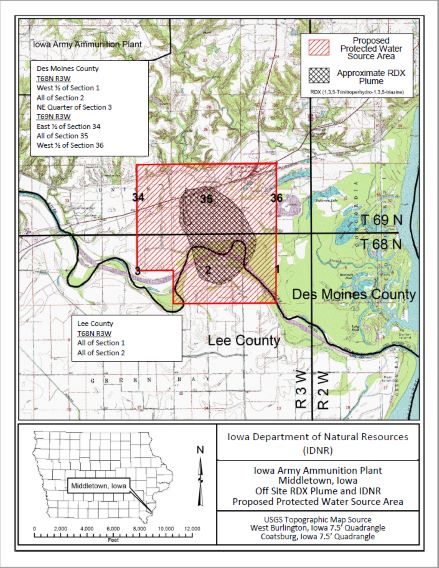 The Iowa DNR is proposing a new Protected Water Source Area for small portions of Des Moines and Lee Counties. The Area is needed because of local groundwater contamination classified as Royal Demolition Explosive or RDX.
The Iowa DNR is proposing a new Protected Water Source Area for small portions of Des Moines and Lee Counties. The Area is needed because of local groundwater contamination classified as Royal Demolition Explosive or RDX.
Protected Water Source areas are described in rule within 567 Iowa Administrative Code Chapter 53. They are only proposed and created when there is a need to ensure the long-term availability of the water sources and to preserve public health and welfare.
A PDF that shows the proposed boundaries of the Protected Water Source Area can be found by clicking on the map near this text, or at the following link: Map of proposed Protected Water Source Area.
The Area is currently defined as follows:
In Des Moines County, T68N, R3W, the West ½ of Section 1, all of Section 2, the NE quarter of Section 3, and in T69N, R3W, the east ½ of Section 34, all of Section 35, and the west ½ of Section 36.
In Lee County, T68N R3W, All of Section 1 and all of Section 2.
Under the current proposal:
- Private water supply wells in The Area will no longer be permitted through local county environmental health departments - Iowa DNR will be the only well construction permit authority within the proposed area.
- Well water use must not create human health exposures, cause movement of the contaminant outside of The Area, or increase the level of the contaminant in any aquifer.
- When new wells can be approved, the construction standards must be approved by Iowa DNR prior to construction, and provide redundant protections of the deeper, currently protected aquifer(s).
- Water quality monitoring will be required to track water quality in the aquifers.
These steps are intended to help ensure that well installations will not expose well users to RDX contamination, and the deeper currently protected aquifers are not impacted by the contaminant due to improper well construction and unauthorized water use.
The United States Environmental Protection Agency  (USEPA) has a fact sheet that discusses RDX contamination. The doucment can be viewed by clicking on the image on the right of this text or on the following link: EPA Technical Fact Sheet on RDX.
(USEPA) has a fact sheet that discusses RDX contamination. The doucment can be viewed by clicking on the image on the right of this text or on the following link: EPA Technical Fact Sheet on RDX.
This notification area will be updated as rulemaking activities progress. You can use the contact information below to inquire about the Proposed Protected Water Source Area or to provide comments about this activity. Erik Day, phone 515-725-0237, or by email at erik.day@dnr.iowa.gov, or by US Postal Service mail addressed to Erik Day, Iowa DNR Water Supply, 502 E. 9th Street, Des Moines, IA 50319.
Preliminary comments were to be submitted to the Department by January 10, 2019. Additional opportunities for public comments will be available as the proposed rule moves through the rulemaking process.
Learn more about this site at the USEPA Superfund website.
Notice to Iowa Certified Well Contractors - Updated March 30, 2021
After taking this last year to review the situation, we have seen a number of conferences and continuing education unit (CEU) opportunities resume, but with online or virtual attendance required. Due to these circumstances, the decision was made to reinstate CEU requirements for the current renewal period, 2020-2022. However, the required number of CEU credits for the 2020-2022 renewal period will be reduced by half. Well drillers will need to earn 0.8 CEUs (8 contact hours) and pump installers will need to earn 0.5 CEUs (5 contact hours) by March 31, 2022.
The CEU requirements for the 2022-2024 renewal period will return to normal (drillers – 1.6 CEU’s or 16 contact hours; pump installers – 1.0 CEUs or 10 contact hours).
To check how many CEU contact hours have been submitted by training entities on your behalf or by you, please use the following web link:
Iowa DNR Operator Certification Database
Well Contractor COVID-19 Resources by The National Groundwater Association

Rural properties that come up for sale commonly have one or more water wells located somewhere on the parcel. Many times, a well provides the only drinking water supply available for the property. Did you know that there's more to understanding the safety and reliability of the drinking water supply than taking a water sample and sending it to a testing lab?
The Private Well Class has web based training that will help you understand what you should look for when a property has one of more water supply wells. Videos are available for your convenience at the following You Tube video link: What Realtors need to know about homes with well water.
https://www.youtube.com/user/privatewellclass

The DNR has a guidance document available to help well contractors, irrigation equipment provides, and well owners understand the requirements of developing high capacity wells.
High capacity wells are wells that withdraw 500 gallons per minute or more from groundwater sources.
The installation of all high capacity wells require the collection and submission of specific information before a Water Allocation and Use permit can be issued and the well put into high capacity service. This is an important step in assuring you can use quantity of water you need.
This information includes a detailed inventory of nearby wells, a complete set of borehole cutting samples, a detailed well log from the test well or production well, and a well pump test to verify the characteristics of the well, like the well's maximum capacity, pumping and non-pumping water levels, and potential for well interference with nearby wells.
Depending on well location and aquifer used, the applicant may be required to conduct an extended pump test to better define the effects the proposed water withdrawal has on nearby wells. If this test isn't performed at the time the well is drilled, the well owner will need to hire a well contractor to perform this step.
The pump test must be long enough in duration to achieve a stabilized water level in the test well or production well, and in the required observation well(s). It can take up to 72 hours of continuous test pumping to achieve a stabilized water level. This is why it's important to plan ahead when a high capacity well is in your plans.
During the test pumping, water level measurements are taken from the production and observation well(s) at predetermined intervals and the information accurately documented on a pump test log. This helps determine how much influence the new high capacity well has on the aquifer and nearby wells. Additional details can be found in Iowa DNR Technical Bulletin 23.1.
All pump test information is used to help the well owner secure a Water Allocation and Use Permit. A Water Allocation and Use permit is issued to convey the legal right to pump and use 25,000 gallons or more of water a day for a beneficial purposes, like crop irrigation or industrial processes.
Typical examples of water use permit holders include, but are not limited to: public water supply systems, power plants, manufacturing and processing industries, agricultural businesses, irrigation users (crop/agricultural, golf courses, turf or truck farms, and athletic fields), rock and gravel quarry operations, construction and temporary and permanent dewatering operations, recreational water uses and heating and/or cooling systems.
A Water Use Permit is required for any person or entity that withdraws 25,000 gallons or more of water in a 24-hour period. The permit lists the amount of water that can be withdrawn each year by the permittee and is valid for up to 10 years. A Water Use Permit also requires that a Water Use Report be submitted to the Iowa DNR each year.
To find out more about Water Use Permits or to apply for yours today, please refer to the Water Supply Engineering Water Allocation and Use website.
Here are a number of additional resources you may find helpful.

The Illinois State Water Survey and the Illinois Water Resources Center at the University of Illinois are pleased to announce a new nationwide training initiative funded by the Rural Community Assistance Partnership (RCAP) through a grant from the U.S. Environmental Protection Agency.
The training will includes classes for those who own or use private water supply wells, and individuals who are just curious about how wells function.
The Private Well Classes are designed to help you understand the basic science of water wells and inform them of best practices to maintain and protect the water supply. These basic tools can help you make informed decisions regarding your water supply. This helps ensure a safe drinking water supply and extend the life of the well.
The classes are part of an online learning experience that includes monthly emails with class lessons that are reinforced by monthly webinars you can - AND - you can attend as often as you wish, even after the emailed class materials have ended. Click here to find out how the class works.
The course include a Resource Library and Multimedia Learning area to provide specific learning tools. http://privatewellclass.org/library or http://privatewellclass.org/multimedia
Or you can use the YouTube Channel for Private Well Classes found at the following link:
https://www.youtube.com/user/privatewellclass.
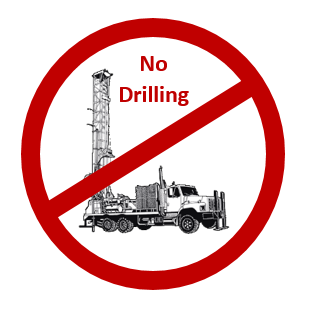 There are a number of areas in the state where it's not possible to install water supply wells or geothermal wells and boreholes. The most common reasons for this type of restriction is because of local groundwater contamination, or to provide aquifer water level protection in specific areas where an aquifer is experiencing high rates of water use.
There are a number of areas in the state where it's not possible to install water supply wells or geothermal wells and boreholes. The most common reasons for this type of restriction is because of local groundwater contamination, or to provide aquifer water level protection in specific areas where an aquifer is experiencing high rates of water use.
There are two methods used to manage drilling restrictions - Environmental Convenants (ECs) and Protected Water Source Areas (PWSAs). Either method essentially achieves the same result - limiting or restricting drilling or access to the groundwater.
Environmental Covenants (ECs) are the most common form of restriction and can be associated with many types of contamination. A few examples include Leaking Underground Storage Tanks - also known as LUST Sites, sites contaminated with industrial products or wastes, industrial landfills, and old dry cleaning facilities. Keep in mind that if multiple small areas of contamination are in close proximity to each other, the overall size of an EC can be quite large - up to and including an entire community.
ECs are developed through agreements with citizens or local governments. They are used when local drilling activities may cause movement of contaminants. The movement may be off-site into currently uncontaminated zones, movement of higher contaminant concentrations into an area that was known to be at a lower concentration, or vertically which can result in contamination of the local aquifers and nearby water supply wells.
If drilling activities cause problems with a contaminated site, it increases the liability for the owner of the site, the owner of the property where the drilling is taking place, and the well contractor performing the drilling.
The department maintains a list of the communities that have ECs. You can use this information to help identify areas where drilling may not be possible. The following link will open a PDF list of the current communities that maintain an Environmental Covenant.
Communities that restrict well drilling activities
Protected Water Source Areas (PWSAs) are developed when the protections needed are greater than can be provided by using ECs, or when the area of contamination is large. PWSAs are developed in state rules which provide for a higher level of management, tracking, and enforcement.
A list of current PWSAs can be found in 567 Iowa Administrative Code Chapter 53.
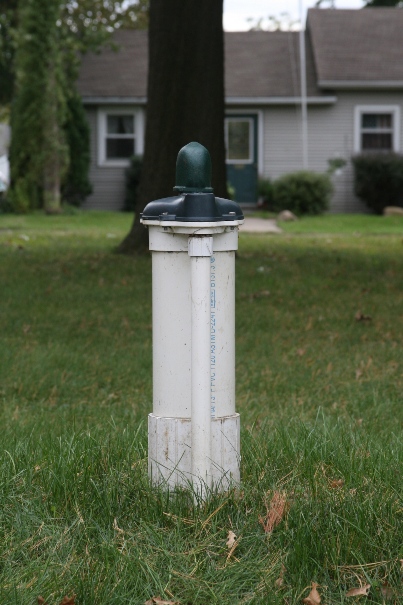
The Iowa DNR Private Well Program provides regulatory oversight on a number of different types of vertical boreholes and borings that meet the legal definition of "well" in our state.
These well structures include:
- Private potable water supply wells like household and acreage wells. Basically, any water supply that is not regulated as a Public Water Supply.
- Private non-potable wells used on farm and in industry, like: Livestock wells, commercial water supply wells, manufacturing and processing water supply wells; cooling tower water supplies; and any other water well that supplies water for non-potable use.
- Irrigation wells for all uses including row crop irrigation, turf production, water for truck gardens and home yard irrigation.
- Temporary and permanent dewatering wells used to lower water tables to allow for subsurface construction or stabilization.
- Geothermal heat exchange water supply and reinjection wells used to exchange heat from a structure to the groundwater.
- Geothermal Heat Exchange (GHEX) closed loop boreholes used to exchange heat from a structure to the earth.
- Temporary and permanent test, observation and monitoring wells used to determine the quantity or quality of the groundwater or to monitor water groundwater levels.
- Temporary and permanent piezometer or monitoring wells used to look for contaminants in soils or groundwater.
- Direct push type technology for groundwater sampling when a temporary or permanent well casing and/or well screen is installed in the ground.
The Private Well Program rules only apply to water supply wells and systems that serve fewer than 25 individuals on a daily basis. If a water system serves water to 15 or more service connections (like campground spaces or condos) or serves at least 25 individuals, the system requires management under the public water supply rules.
Examples of smaller water systems that meet the definition of Public Water Supply definition includes but is not limited to:
- rural churches,
- rural restaurants, bars and entertainment venues,
- rural industrial or manufacturing facilities,
- rural trailer parks,
- rural wineries,
- rural conference or meeting halls,
- certain rural day care facilities,
- and any other place that is not connected to a municipal or rural water public water supply where the public gathers or conducts business and 25 or more individuals have access to the water.
Public Water Supplies have specific federal requirements to help protect the health of the water users and the integrity of the water system. These requirements address the design of the water well and water treatment systems as well as the storage and distribution systems. The design and construction of these facilities must follow approved specifications and standards as determined by the Iowa DNR Water Supply Engineering section. In addition, a Public Water Supply must manage and monitor the water system according to an operation permit issued by the Iowa DNR Water Supply Operations section. These steps help ensure that the water available and used by the public is safe for consumption. To find out if you are a Public Water Supply or for more information regarding Public Water Supply requirements, contact the IDNR Water Supply section at 515- 725-0282.
The Private Well Program provides administrative oversight of the statewide private well program. This includes rule development and interpretation, working cooperatively with local county governments to administer the private well program at a local level, working with well contractors regarding minimum and appropriate standards for well services, and providing guidance to private well owners and other citizens.
The goals of the Iowa DNR Private Well Program are to:
- Protect the groundwater resources and public health by establishing well construction, well maintenance and well plugging standards.
- Establish and maintain well contractor certification requirements for all types of boreholes that meet the definition of "well."
- Provide a source for accurate and meaningful guidance to help answer questions pertaining to the private well program areas.
The program goals are to have all wells constructed to appropriate minimum standards and that competent Iowa DNR Certified Well Contractors are on-site in direct control of each well service provided.
To help achieve the program goals the Private Well Program works with local county environmental health staff to issue private well construction permits at the local level. This relationship is an important part of the program and helps to ensure that there are local contacts to help local residents with permitting and construction information needs.
The Iowa DNR private well construction permit is issued by your local county on a web based private well permitting system known as the Private Well Tracking System or PWTS. This system electronically records well permit information as well as record and track well water testing reports, well renovation reports and well plugging reports.
The Private Well Program also works with the Iowa DNR Operator Certification Section to help Certified Well Contractors with their certification questions and testing, and helps training providers determine if a training event will qualify for continuing education units (CEUs) or "contact hours" for Iowa's well contractors.
You will find additional private well related topics in the left hand column or menu area of this web page. There are also useful links at the bottom of each web page for common private well topics. If you cannot find the information you are looking for, please contact us using the information at the bottom of this page.
The graph below provides the number of state private well construction permits issued each year in Iowa between 2002 through 2018. Both water supply wells (WW) and geothermal loop boreholes (GHEX) are shown. Click the graph to download a PDF version of the document.
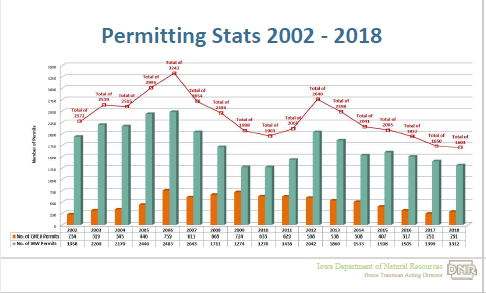
You can take the following steps to help protect your water supply well and the groundwater used by you and others:
- Maintain your well by inspecting, repairing, and replacing sanitary items as needed. This helps the well protect your water supply.
- Limit your use of pesticides, fertilizers, or other chemicals that may impact the groundwater.
- Store all farm chemicals in leak free closed containers, placed far from the well site. Apply all chemicals in strick adherance to the label directions, and never dispose of unneeded products onto the ground, or in storm sewers, sanitary sewers, or water ways.
- Store all household chemicals away from the well and in leak-free containers. Apply all chemicals in strick adherance to the label directions, and never dispose of unneeded products onto the ground, or into storm sewers, sanitary sewers, or water ways.
- Use backflow prevention devices on all hydrants and water spigots - especially if used to mix any type of contaminant.
- Take used motor oil and antifreeze to a recycling center.
- Be careful when you are doing any activity around the well so you don't damage the well cap, well wire conduit, well casing, or well vent. Even minor bumps can cause unseen damage that can affect well water quality.
- Respect the resources you use. Conserve your water even if you don't have to, because water is a valuable resource and the cost of providing clean, safe water will only increase if we all don't do our part.
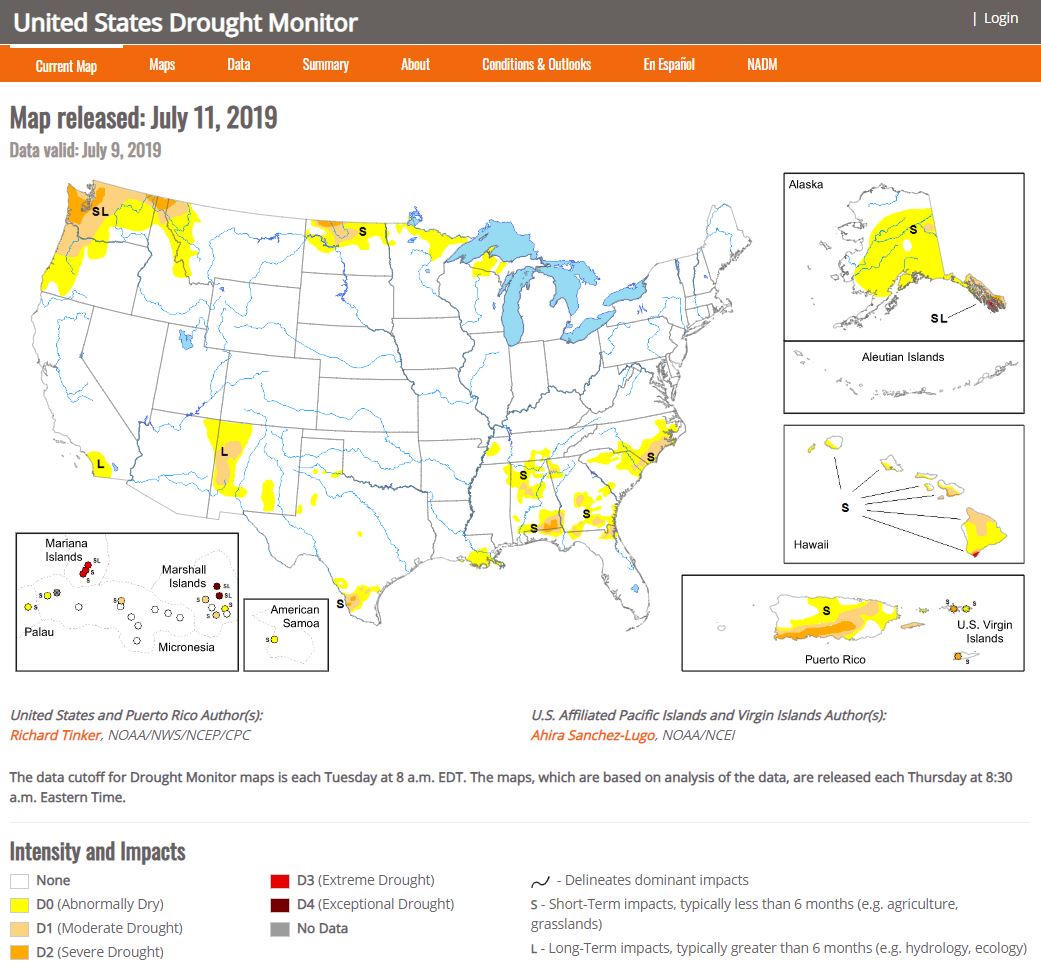 The U.S. Drought Monitor (USDM) is a map that is updated each Thursday to show the location and intensity of drought across the country.
The U.S. Drought Monitor (USDM) is a map that is updated each Thursday to show the location and intensity of drought across the country.
Learn more by visiting the Drought Monitor website.
The USDM uses a five-category system to display drought conditions. There are labeled:
- Abnormally Dry or D0, (a precursor to drought, not actually drought),
- Moderate (D1),
- Severe (D2),
- Extreme (D3), and
- Exceptional (D4) Drought.
Drought categories show experts' assessments of conditions related to dryness and drought including observations of how much water is available in streams, lakes, and soils compared to usual for the same time of year. U.S.